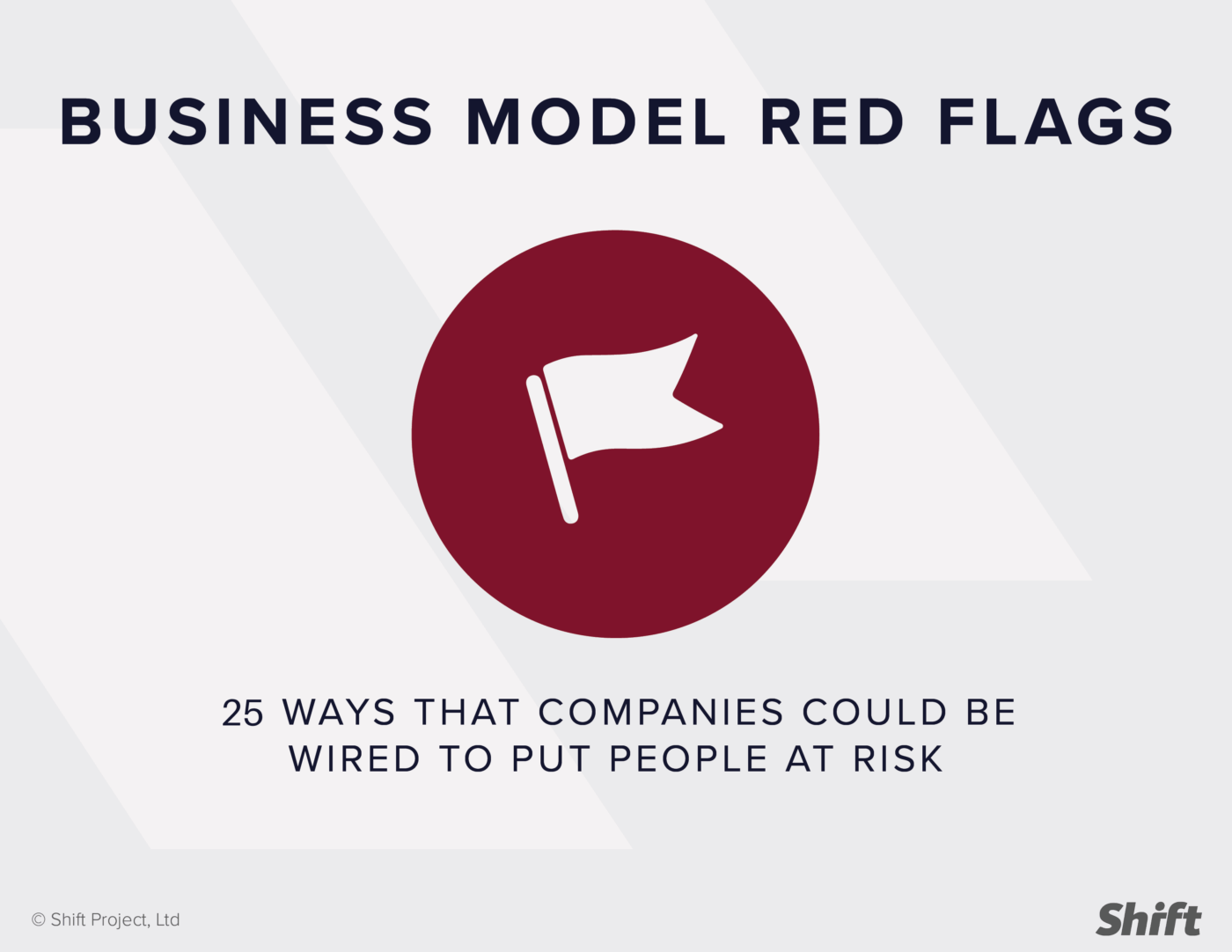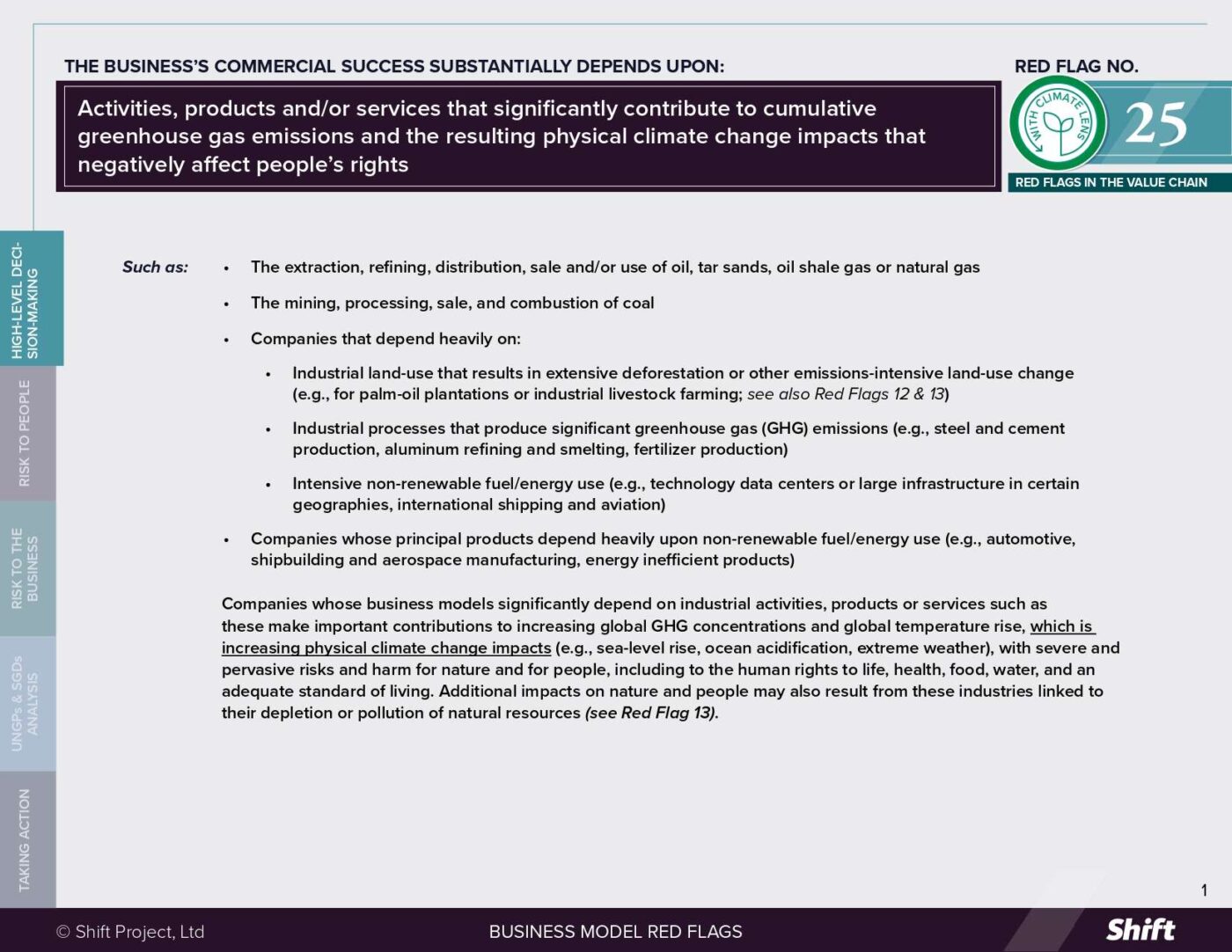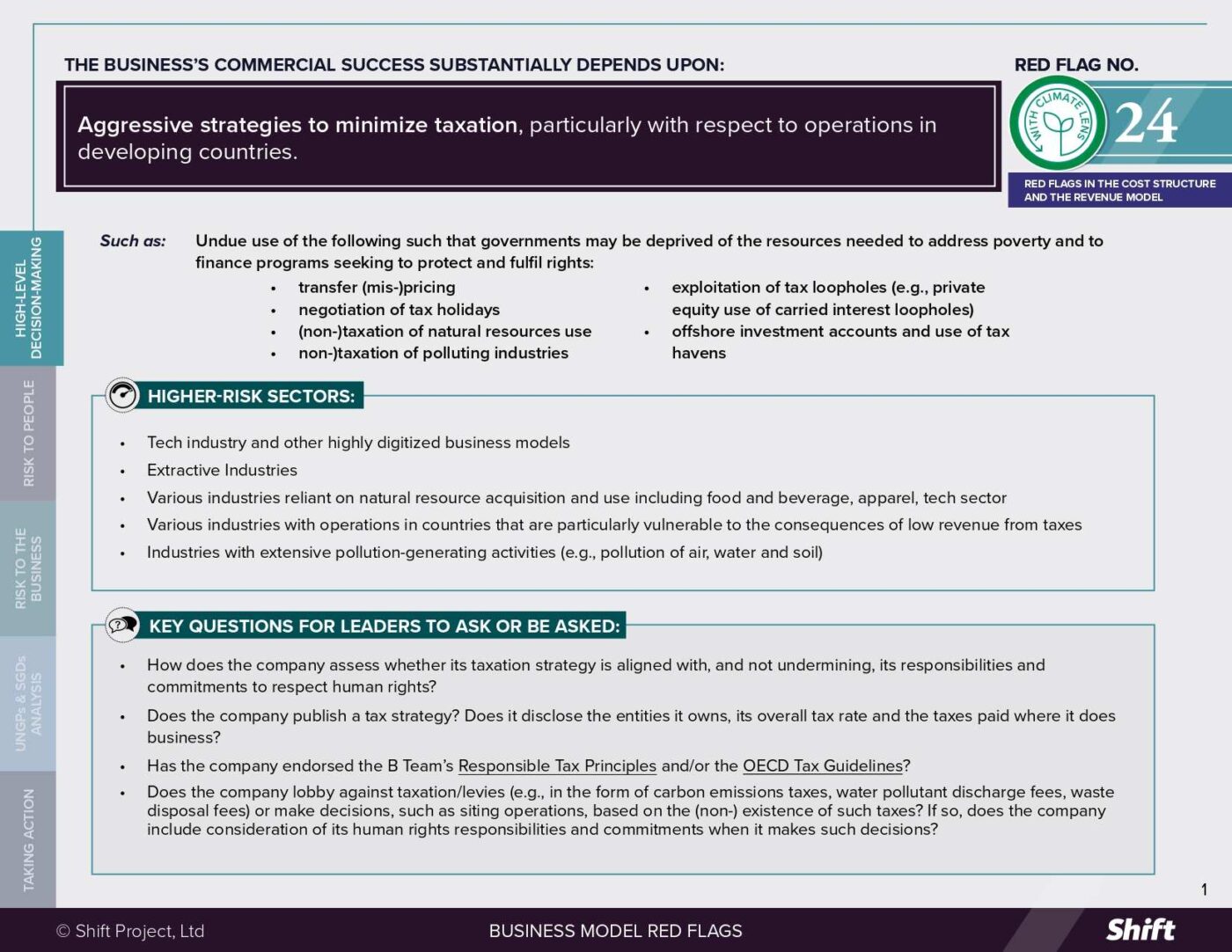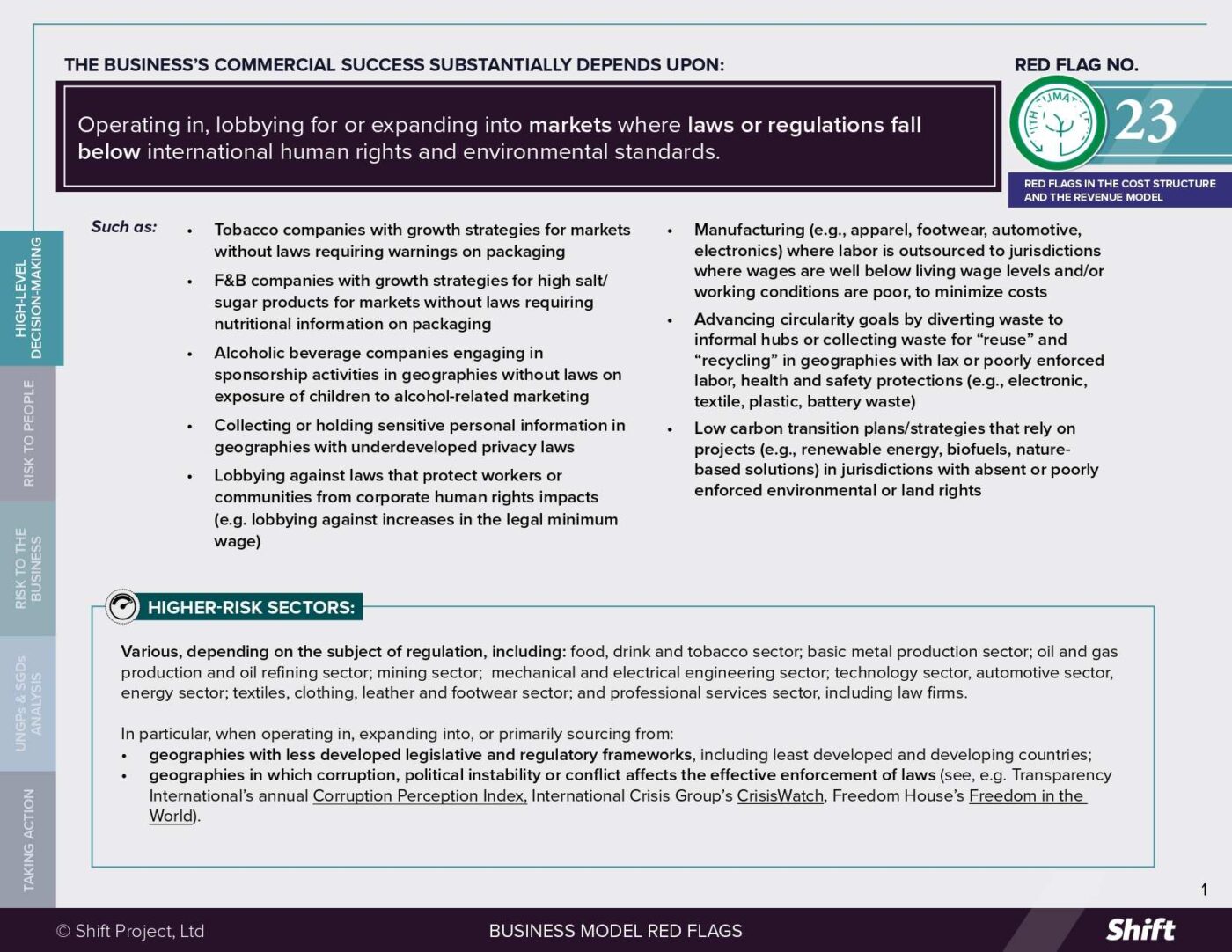RED FLAG # 21
Rapid digitalization of processes and key functions such that planning or support for upskilling or redeployment of displaced employees is challenging to achieve.
For Example
Businesses that employ workers in routine physical roles that can be substituted with AI and robots, or in roles where AI and robots can work alongside people across sectors such as:
- Manufacturing
- Transport and logistics
- Agriculture
- Extractives
Businesses across multiple sectors where
Generative AI can perform key functions or where digitalization makes certain white-collar jobs redundant, thus replacing a significant part of the workforce, such as:
- Retail and e-commerce
- Marketing and advertising
- Entertainment and content creation
- Education and e-learning
- Healthcare
- Financial services
- Information Communication and Technology services
- Power generation and distribution
Higher-Risk Sectors
Digitalization is happening across more or less all industries, in different forms. The potential displacement of workers is currently most prevalent/expected in:
- Manufacturing: predominantly in the automotive, apparel and electronic industries, but increasingly in the manufacturing of fast-moving consumer goods and garments. Whilst already highly automated, AI is increasingly used to optimize production processes and improve quality control
- Transport and logistics: picking, stowing, moving stock in warehouses
- Agriculture: to replace repetitive tasks in operations that employ a steady year-round workforce, or to perform detailed tasks such as improving crop yields, monitoring soil conditions, and optimizing irrigation
- Extractives: to remove people from underground environments or using unmanned vehicles for transporting materials to reduce costs, achieve longer operating hours and improve health & safety
- Oil and gas: moves towards a more automated renewables sector and greater automation in oil and gas exploration, extraction and processing
- Energy: using AI for predictive maintenance, to enhance energy systems, establish smart grids etc.
- Professional and financial services: increased use of AI and blockchain that replaces routine legal and financial services
- Entertainment and content creation: AI is used to generate music, videos, and other creative content.
- Education and e-learning: AI is used to personalize learning experiences, provide automated tutoring, and generate educational content
- ICT services: AI is used for troubleshooting and maintenance, cyber security, solution optimization and efficiency etc.
Questions for Leaders
- Does the company foresee automating roles? How does the company plan for digitalization?
- Have we identified employees who are especially vulnerable to the effects of increased automation and use of AI?
- Have we considered scenarios in which we digitalize at a pace and scale that will be less disruptive to the lives and livelihoods of our workforce?
- Are we providing employees training to build their skills to take on new types of work as we increasingly digitalize?
- Do we engage with workers whose jobs may be affected by digitalization to understand their concerns and needs?
- Do we give due consideration to the possibilities for retraining or re-skilling workers, including in our climate transition plan?
- Does our offering to customers drive digitalization of other industries and have we considered the impacts on workers in the operations and value chains of the customers we support?
How to use this resource. ( Click on the “+” sign to expand each section. You can use the side menu to return to the full list of red flags, download this Red Flag as a PDF or share this resource. )
Understanding Risks and Opportunities
Risks to People
Digitalization – understood as the process of leveraging digital technologies to transform business models – includes increased use of generative AI and other forms of automations, such as replacing people with robots. Digitalization is driven by technological advancements and reduced technology costs, competitive pressure and efficiency gains, increased need for data-driven decision making, increased labor costs and changing workforce demographics (aging and labor scarcity).
Additionally, the COVID-19 pandemic forced many companies and industries to embrace digital solutions and remote capabilities, further accelerating the digitalization of business.
Technologies such as artificial intelligence (AI), Internet of Things (IoT) and cloud computing, are all key enablers in digitalization of businesses.
Technological change is currently predicted to be the most divergent labor market change, with broadening digital access expected to both create and displace more jobs than any other macrotrend (19 million and 9 million, respectively). Meanwhile, trends in AI and information processing technology are expected to create 11 million jobs, while simultaneously displacing 9 million others, more than any other technology trend. Robotics and autonomous systems are expected to be the largest net job displacer, with a net decline of 5 million jobs.
Research shows that at most 2.3% of jobs across the world have the potential to be fully automated. Many jobs, however, have a significant percentage of automatable activities. Automation’s greatest impact is forecast to be on jobs that consist of routine activities in predictable environments.
Digitalization of processes through automation and the use of AI can have a number of positive impacts.
In the short term, it can:
-
Remove unsafe jobs: in mining, robots can help remove people from dangerous underground jobs, for instance, in Resolute’s Syama mine in Mali.
-
Help people with restricted physical ability work.
-
Make jobs more accessible for local workers: in mining, robots can provide a simpler visual interface which makes it easier for companies to train local workers, rather than rely on highly skilled workers from outside the area.
-
Help manage labor shortages: for example, labor shortages exacerbated by Covid-19 incentivized investment in agricultural robots.
-
Increase access to e.g. healthcare, education and financial services through the use of AI solutions.
In the long term, AI and automation can create new jobs and increase the need for higher-skilled workers.
Estimates of the number of automatable jobs vary quite widely. For example, a study by McKinsey estimates that 50% of current work activities are automatable, and that by 2030, 400 million workers could be displaced by automation and 75 million will need to change occupational category. This shift will put enormous pressure on workers around the world.
Automation and the use of AI can more negatively affect people who are already vulnerable: low paid and precarious workers, workers in least developed countries, women and minorities that are over-represented in automatable jobs or under-represented in sectors that are likely to experience job growth. For example:
-
In the US, African American workers are projected to be disproportionately affected by automation because they are over-represented in sectors such as transportation, food service and office clerks. According to research of 2022 data, some 24 percent of all Black workers are in occupations with greater than 75 percent automation potential, compared with just 20 percent of White workers.
-
In Bangladesh, automation in the ready-made garment (RMG) industry has resulted in a 31% decline in the workforce and disproportionately affects women, who comprise 80% of the workforce in the sector.
-
The fact that many jobs can be replaced by AI also potentially disrupts the role of trade unions and strike actions, as demonstrated by a case related to the New York Times, where an AI company offered to replace the striking workers with AI solutions, effectively undermining the strike action.
The negative impacts of digitalization on people are in large part a result of the way in which companies introduce and use robots and AI solutions. The common denominator in cases of digitalization going wrong (where workers are dehumanized and seen as another input or cost in the production process) is lack of empathy: the ability to put oneself in someone else’s shoes.
When companies introduce digitalization without empathy with workers, the risks to people can be:
-
Loss of Livelihood: Workers who lose their job because they are unable to relocate, retrain or redeploy. ILO research shows that the potential impact on women is roughly 2.5 times greater than on men. Estimating that 1.4% of men’s jobs globally have the potential to be automated, compared with 3.7% of women’s employment. In high-income countries, where clerical jobs (typically held by women) make up a greater proportion of occupations, the effects are more striking: 2.9% of men’s jobs compared with 7.8% of women’s jobs.
-
Lower Wages: Studies have found that workers directly affected by robot adoption—particularly those in routine blue-collar roles—experienced wage decreases of approximately 6%. Other studies indicate that displaced low-wage workers may suffer a 13% reduction in income six years after job loss. Research also shows that technology which replaces workers without increasing productivity tends to depress wages of low-skilled workers. Other research indicates that growth in the wage gap in the U.S. could come from automation displacing low-skilled workers. In terms of young workers, a 2019 study focused on the U.S. Midwest indicated that an increase of one robot per 1,000 workers correlated with a 4% to 5% wage decline for young, less-educated men and women in manufacturing sectors. It found that minority young workers in the sample – less-educated Black men and women – faced the most significant negative impacts from robot adoption, exacerbating existing wage disparities.
-
Workplace Accidents: While automation of hazardous tasks leads to a decrease in work-related injuries, an investigation into Amazon warehouses where robot use has increased, showed that injuries were 50% higher, due to increased productivity targets for workers rolled out as a result of the productivity gains of automation.
-
Mental Health Problems: Research shows that automatable work has a detrimental impact on the mental health and life satisfaction of workers within some industries, particularly those with higher levels of job automation risk, such as manufacturing. Other studies show robot penetration was associated with sizable increases in drug and alcohol-related deaths and mental health problems among current and former workers. The OECD notes that AI-driven tools can lead to a decline in social contact and negatively affect workers’ well-being and productivity. A study analyzing data from 20 European countries found that increased robot adoption led to significant declines in workers’ sense of autonomy and job meaningfulness. The integration of AI tools for monitoring productivity has led to increased surveillance, causing stress and anxiety among workers. For instance, UPS drivers reported that sensors in delivery vehicles tracked every aspect of their workday, leading to feelings of constant scrutiny and reduced autonomy.
-
Rising income and wealth inequality: While automation and robots have already displaced low- and middle-skill jobs involving routine tasks, generative AI’s capabilities extend to more intelligent automation, potentially replacing more advanced tasks and occupations. Studies show that this could lead to an increase in income and wealth inequality, which in turn and over time can impact the enjoyment of a wide range of human rights, such as access to basic goods and services as a result of increased costs of living.
In the context of the low carbon transition, digitalization can enable and accelerate decarbonization, for example through the use of automation, robots and AI to optimize efficiency, reduce energy consumption, enhance worker productivity, as well as help to address labor and skills gaps. However, there may also be negative impacts for people, such as employers bypassing workforce training and upskilling by deploying digital and AI solutions in response to “green skills” shortages.
Further, if not managed appropriately, the simultaneous economic transformations of decarbonization and digitalization have the potential to exacerbate impacts on people within sectors. For example, in the oil and gas sector, skilled labor for roles such as oil and gas exploration may become increasingly automated, while overall demand for fossil fuel exploration is declining in response to the low carbon transition, amplifying the impact on jobs.
Finally, whilst AI can be used to improve efficiencies, AI & blockchain solutions are very high energy consumers and significant contributors to global GHG emissions, which, left unaddressed, will contribute to worsening physical climate impacts. (See Red Flag 25)
Risks to the Business
|
Operational Disruption and Reputation Risk due to Worker Concerns and Insecurity: Where companies automate – and this is done in ways that leave workers uncertain or insecure about their livelihoods – those companies can face public protests, union action, strikes and calls for boycotts. Examples of this include: Australian retailer Coles announcing the automation of warehouses (2020); Hollywood strikes over the use of generative AI in the movie industry (2023), and dockworkers in the U.S. protesting against automation (2024). Potential Loss of Social License and “Local Content” Incentives: In cases where governments have offered incentives for businesses to set up operations and employ local people, (e.g. in the extractive industry), it may be that large-scale layoffs due to rapid automation will undermine the support of the local government and the population. Research is looking at a so called “social license to automate” in the mining industry and how local communities and workers are impacted by the increased automation. Financial Risk:
Legal and Regulatory Risk:
Financial Stability Implications of AI: The increased use of AI in the financial sector brings with it challenges from a financial stability point of view, which can impact companies financially in the short- and long-term. Research by the Financial Stability Board identifies that the widespread use of common AI models could lead to increased correlations in trading, lending, and pricing, as well as potential third-party dependencies. This could in turn amplify market stress, exacerbate liquidity crunches, and increase asset price vulnerabilities. The market for these products and services is also highly concentrated, which could expose financial institutions to operational vulnerabilities and systemic risk from disruptions affecting key service providers. |
What the UN guiding principles say
A company may contribute to negative human rights impacts when it lays off workers as a result of rapid digitalization without first trying to offer re-skilling or upskilling opportunities.
For example, in contexts where there is a weak social safety net or where workers lack alternative employment options or sources of income, rapid digitalization can result in job losses that leave workers without ways to secure an adequate standard of living. Compounded by the socio-economic context, this can negatively affect workers’ right to health, adequate housing and nutrition.
Buyers and investors may also contribute to negative human rights impacts if they require, respectively, their suppliers or investee companies to digitalize with no time to support workers in contexts where there are weak social safety nets.
A company that enables the digitalization of other industries, e.g. by developing AI and automation solutions, may contribute to negative human rights impacts by providing such solutions to customers without considering mitigation measures such as supporting affected workers in the transformation.
Possible contributions to the SDGs
Technological progress is crucial to the fulfilment of all the SDGs, including with respect to SDG 7 Affordable and Clean Energy, SDG 12 Responsible Consumption and Production, and SDG 13 Climate Action. However, to be true to the purpose of the SDGs, the use of technology needs to be underpinned by an understanding of how the loss of jobs due to digitalization can affect people’s basic dignity and rights.
Digitalization with empathy and with support for workers to re-train or upskill can help companies fulfil the following SDGs:
-
SDG 8.5: Achieve full and productive employment and decent work for all women and men, including for young people and persons with disabilities
-
SDG 9.2: Promote inclusive and sustainable industrialization
Taking Action
Due Diligence Lines of Inquiry
While the scale of digitalization’s impacts on people is undeniable, the nature and gravity of those impacts will depend on the way in which companies apply technology. This includes the due diligence companies carry out to identify and address negative impacts on people. Important questions to consider are:
-
Does the company have a culture of empathy that looks not just at the benefits but also the human impacts of digitalization?
-
Do we seek to understand what workers expect from their jobs in terms of progression and development?
-
Do we ask how workers feel about the technology that surrounds them at work?
-
Do workers have alternative employment options? (Are we the only significant employer in the local area?)
-
How robust is the social safety net for workers who are displaced from their jobs?
-
-
Does the business have in place processes to minimize the harm to workers of introducing and using robots and AI solutions?
-
Do we have a process to assess impacts on people of new technology or automation in our operations?
-
Do we look for unintended negative consequences from technology meant to make work “faster and easier”?
-
Do we provide workers with opportunities for continuous learning? Do we recognize and reward that learning?
-
Are our governance and internal processes and controls able to manage the additional complexity that comes with automation and technology?
-
How do we engage with other stakeholders – including governments and trade unions – to identify ways to prepare workers for a changing landscape of work?
-
Have we considered what part of our workforce (specific job roles, geographies etc.) may be especially vulnerable to impacts as a result of digitalization?
-
Does the company support workers in the transformation to the need for new skills as a result of digitalization?
-
How does the company propose to fill any skills gaps resulting from digitalization? Are there plans for retraining/upskilling staff?
-
Has the company considered the energy consumption involved with digitalization, e.g. use of AI, automation etc. and associated impacts on people?
-
Mitigation Examples
* Mitigation examples are current or historical examples for reference, but do not offer insight into their relative maturity or effectiveness.
Companies that introduce rapid digitalization should take steps to identify and mitigate the potential negative impacts on workers who lose their jobs as a result.
Mitigation examples fall into four categories:
-
Engaging with Workers: Giving workers early notice that their jobs will be affected and engaging with them to understand their needs and expectations. Examples are:
-
Research and forecasting: The European Centre for the Development of Vocational Training provides skills forecasts showing changes in the labor force and types of job openings, which enable workers, employers and governments to prepare in advance.
-
Engaging workers in the transformation: IBM has adopted a policy of open dialogue regarding workforce transformations involving AI. In which the company updates impacted team members through employee forums and dialogues.
-
Moderna merged its technology and human resources departments to address the evolving landscape shaped by AI advancements. It reports that this move aimed to redefine work responsibilities, distinguishing between tasks best suited for humans and those that can be automated.
-
Accenture involved its employees in designing and testing a custom version of OpenAI’s ChatGPT to assist in crafting sales proposals, engaging staff in the development process and providing training.
-
-
Supporting Redeployment or Relocation of Existing Workers: Companies can redeploy workers through upskilling or retraining. Examples are:
-
Companies such as Amazon, IKEA and Pwc have announced programs to upskill their workforce to help them move from positions vulnerable to automation to other jobs.
-
Pilot projects in Bangladesh aim to increase workers’ digital literacy and use of computer-based design to adapt to the increased use of automation in garment factories, at the same time addressing gender imbalances by focusing the training on women.
-
The Georgia Artificial Intelligence in Manufacturing (AIM) program, launched by Georgia Tech, aims to reskill manufacturing workers by providing training in AI and emerging technologies. This initiative supports small and mid-sized manufacturers in adopting smart technology and establishes a pipeline of skilled workers to sustain employment in the manufacturing sector.
-
-
Supporting Future Workers to Access the Labor Market: Examples of companies helping future workers develop skills abound, including:
-
Collaborating to help unemployed youth enter the labor market: in the UK, companies such as Centrica, Tesco and Starbucks have partnered with Movement to Work to implement programs to tackle youth unemployment.
-
IBM’s SkillsBuild is a free education program aimed at underrepresented communities, including adult learners, high school and university students, and faculty. It offers over 1,000 courses in 20 languages covering topics like artificial intelligence, cybersecurity, data analysis, and cloud computing. Participants can earn IBM-branded digital credentials recognized in the industry.
-
-
Using Leverage to Advocate for Public Policies: e.g. wage insurance, universal basic income, smart taxation, closing the gender gap in STEM degrees (only 27% are women).
-
Businesses can use their leverage to signal to governments changes needed in education curricula: for example, the Confederation of British Industry has commissioned research to better understand the curriculum changes needed to prepare young people to access the labor market.
-
The Future Skills Centre in Canada emphasizes the pivotal role of employers in upskilling initiatives. However, employers face barriers such as time, cost, and information constraints. The Centre is piloting approaches to enhance employer engagement, especially among SMEs, to ensure training efforts are targeted and effective.
-
The Social and Economic Council of the Netherlands is a multi-stakeholder body composed of trade unions and employers’ organizations which makes recommendations to the government on how to mitigate the negative impacts of robotization in the labor market. This type of dialogue can help governments drive education and social policy to better prepare future workers and to prevent the dislocation associated with an increase in automation.
-
France, Italy and Singapore have created personal training accounts, which allow workers to accrue credit which they can use towards training and upskilling and is transferable between employers. This provides workers with training opportunities that are not tied to their current employer.
-
Countries are also creating “skills ecosystems” that enable workers to chart their career path and access lifelong learning, such as Singapore’s Skills Future Movement.
-
Alternative Models
|
Alternative models are examples of companies that retain workers instead of replacing them with robots and/or AI solutions. This does not mean the companies are not automating. It means they are integrating robots and/or AI solutions with their existing workforce in ways that benefit both workers and the business.
|
Other tools and resources
General
-
OECD Employment Outlook 2024: The Net-Zero Transition and the Labour Market (2024)
-
International Labour Office (2019) Work for a brighter future: Global Commission on the Future of Work.
-
WEF, Future of Jobs Report (2025)
-
Luxembourg Institute of Socio-Economic Research (LISER), Augmenting or Automating Labor? The Effect of AI Development on New Work, Employment, and Wages (2025)
-
Oxford Internet Institute, University of Oxford, Complement or substitute? How AI increases the demand for human skills (2024)
-
Universidade Federal do Rio de Janeiro, AI in the Workplace: A Systematic Review of Skill Transformation in the Industry (2024)
-
AI & Society, Artificial intelligence and work: a critical review of recent research from the social sciences (2022)
-
OECD, Equipping and training workers with the right skills for the Green and AI transitions (2024)
Sector specific
-
ILO, David Kucera and Fernanda Bárcia de Mattos (2020) Automation, employment and reshoring: Case studies of the apparel and electronics industries: a study of automation in the apparel and electronics industries.
Regional
-
OECD, AI-WIPS, Artificial Intelligence and Employment: New Cross-Country Evidence, (2022)
-
Indian Institute of Technology Jodhpur, Skill-Based Labor Market Polarization in the Age of AI: A Comparative Analysis of India and the United States (2025)
-
Journal of Technology Innovations and Energy, The impact of Artificial Intelligence and Machine learning on workforce skills and economic mobility in developing countries: A case study of Ghana and Nigeria (2023)
-
Valley View University, Accra, Ghana, The Impact of Artificial Intelligence on Employment: Evidence in Africa (2023)
Citation of research papers and other resources does not constitute an endorsement by Shift of their conclusions.

 Business Model Red Flags
Business Model Red Flags  Tool for Indicator Design
Tool for Indicator Design 



